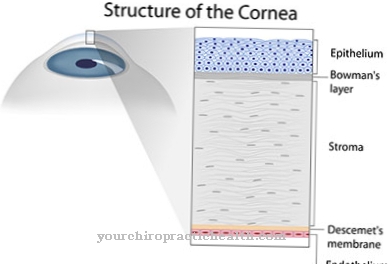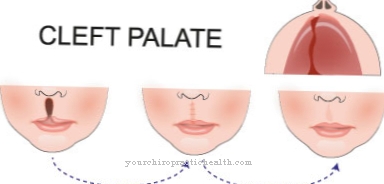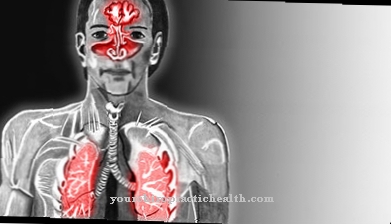Check-ups are very important during pregnancy and should be done. In the event of persistent complaints such as dizziness, ringing in the ears and headaches in the second half of pregnancy, the doctor should be informed to have a pregnancy-related high blood pressure to exclude.
What is high blood pressure during pregnancy?
.jpg)
© Kalim - stock.adobe.com
Pregnancy-related high blood pressure (preeclampsia) is a disease that can only occur during pregnancy. About five to eight percent of all pregnant women develop preeclampsia in the second half of pregnancy, i.e. from the 20th week.
At an earlier stage of pregnancy, the first signs sometimes appear, which are initially accompanied by palpitations, with ten percent of all women having an increase in blood pressure during pregnancy without subsequently manifesting preeclampsia. The disease manifests itself through an increased blood pressure with values over 140/90 mmHg as well as an increased protein excretion in the urine.
The pregnant woman notices this mainly through headaches, ringing in the ears and dizziness. In addition, there is increased water retention in the tissue, especially in the hands and feet. It used to be assumed that the mother's symptoms were triggered by the unborn child who was suspected of poisoning the mother. However, this theory could not be confirmed in pregnancy-related high blood pressure.
causes
The causes of pregnancy-related high blood pressure are not yet known. However, there are a number of assumptions about possible triggers for the disease. In the expectant mother, for example, inflammation of the vessels can occur, which disrupts placenta formation. The inflammatory reaction is a kind of overreaction of the body to the pregnancy.
There is also the possibility that the body cannot produce the higher amount of blood required by the uterus. He reacts with an increase in blood pressure to ensure the stability of the circulation. Malnutrition in the mother is also discussed as a cause of pregnancy-related high blood pressure.
Symptoms, ailments & signs
The first and more subtle symptoms of pregnancy poisoning include increased pregnancy blood pressure, increased excretion of protein in the urine, the accumulation of fluids in the hands, face and feet, and a decrease in the amount of urine. In addition, severe cases are characterized by sudden and severe weight gain, headache, nausea or vomiting, sensitivity to light and visual disturbances.
In particular, pregnant women should watch out for possible pain in the right upper abdomen. The clinical signs of preeclampsia also refer to changes in the blood, which means that the proportion of erythrocytes in the volume of the blood is often just as increased as other blood parameters. Preeclampsia is sometimes difficult to distinguish from kidney disease with combined high blood pressure.
A rise in uric acid levels or an underlying dysfunction of the central nervous system, liver, or other organs can indicate pregnancy-related illnesses. Edema can be observed in more than 80% of pregnant women even without preeclampsia. Again, it is possible to develop preeclampsia without showing any signs of edema. If the pregnancy hypertension persists, the blood vessels of the placenta can be damaged. This reduces the supply of nutrients and oxygen to the unborn child.
Diagnosis & course
Pregnancy-related high blood pressure is recognized as part of prenatal care. The blood pressure values are checked at these appointments. In addition, the pregnant woman has to give urine, which is examined for its protein content. The control of the weight also provides information about a sudden increase due to water retention.
Edema develops in most pregnant women without preeclampsia being present. However, the regular check-ups enable the disease to be treated at an early stage. Existing high blood pressure damages the vessels in the placenta so that the child can no longer receive adequate care.
It is very important to keep the check-up appointments, because if the disease remains untreated, eclampsia can develop. This results in seizures emanating from the brain, which can be life-threatening for both the mother and the baby.
Complications
High blood pressure during pregnancy is usually harmless; however, it can sometimes lead to complications. Chronic high blood pressure, which occurs in the first or second trimester, increases the risk of fully developed preeclampsia. The disruption reduces the supply of nutrients and oxygen to the embryo and affects the baby's growth; there are also seizures and headaches.
Further complications can be kidney failure, brain edema, thrombosis, bleeding, retinal damage and placenta death. If preeclampsia develops into eclampsia, serious complications such as convulsions, severe headaches, and fibrillation are possible. Often these warning signals already occur in the case of chronic high blood pressure, and have a direct impact on the well-being of mother and child.
Rarely, eclampsia can lead to a reduced blood flow to the placenta and thus to an undersupply or death of the child. So high blood pressure during pregnancy can affect the baby's health. In addition, the increased pulse increases the risk of premature birth, internal bleeding and coagulation disorders such as the HELLP syndrome, which in turn can be associated with life-threatening side effects. A medical examination of the high blood pressure usually prevents serious complications and ensures the child's healthy development.
When should you go to the doctor?
High blood pressure is generally considered a risk factor for many cardiovascular diseases. Special care is required during pregnancy. This also applies if there was previously hypertension. Pregnant women should have their blood pressure checked regularly. Values above 140/90 mmHg are considered to be in need of treatment in pregnant women.
If high blood pressure is found, the affected women should see a doctor as soon as possible, as this could be the first signs of preeclampsia. This is a disorder in which pregnant women have high blood pressure and too much protein is excreted in the urine.
If left untreated, a hypertensive pregnancy disorder can lead to life-threatening complications for the mother, cause premature birth or damage the child. A visit to a doctor is therefore strongly recommended. The doctor can also identify possible complications such as eclampsia or HELLP syndrome in good time and initiate the necessary therapeutic measures.
In addition to nausea, vomiting and severe pain in the upper abdomen, HELLP syndrome can also have a number of side effects that are life-threatening for the mother. These include, for example, pulmonary edema, cerebral haemorrhage or acute kidney failure.
Pregnant women should therefore take high blood pressure very seriously during pregnancy and always consult a doctor promptly.
Doctors & therapists in your area
Treatment & Therapy
Treatment for pregnancy-related high blood pressure depends on the severity of the disease. If it is mild, physical rest or bed rest is in the foreground. The woman should pay special attention to her diet.
A high-calorie diet that is rich in protein and sufficiently salted is considered beneficial here. It may be necessary to take antihypertensive agents. If the blood pressure values continue to rise, hospitalization is necessary to ensure constant monitoring. Above all, it is about preventing possible seizures. Antihypertensive drugs are also administered here.
The HELLP syndrome represents a complication in the course of the disease. It is a severe preeclampsia with additional liver dysfunction which can lead to internal bleeding. The mother must be monitored by intensive care. The urine values are constantly checked using an indwelling catheter. It is difficult to gauge how the syndrome will develop.
Sudden deterioration can occur at any time. This condition is life-threatening for both the mother and the baby, so the pregnancy must be terminated by a caesarean section if the child's lungs allow it to mature.
Outlook & forecast
High blood pressure during pregnancy is considered a concern because of its unpredictability. It can increase during pregnancy, occur sporadically or only be measured once. In some patients there is a possibility that, despite all efforts, there will be no relief from the symptoms until the child is born. This is explained by the fact that often the cause of the high blood pressure cannot be found.
Despite rest, balance, a healthy diet and little physical exertion, the symptoms can continue unabated until the birth. Complete bed rest is often the only treatment option to avoid complications. This means that high blood pressure poses an increased risk to the health of the mother and the unborn child.
In severe cases, life-threatening conditions threaten. These can occur in the mother as well as in the child. Various countermeasures can be initiated with early treatment of high blood pressure. In these cases, there is a very good chance of relief from the symptoms. Nevertheless, a prognosis must always be assessed individually.
The return of high blood pressure can also occur with timely and comprehensive medical care. Some pregnant women experience permanent lowering of blood pressure after a single treatment. However, complete freedom from symptoms only occurs after the child is born.
prevention
To prevent pregnancy-related high blood pressure, it is important to attend the check-up appointments regularly. The earlier preeclampsia is recognized, the more favorable the conditions for a mild course of pregnancy-related high blood pressure.
Aftercare
There are several points to consider when following up for high blood pressure during pregnancy. One of the most important points is breastfeeding. There are drugs that can be used to reduce high blood pressure after pregnancy. Since almost all drugs taken by the mother can also be found in breast milk, it is essential to ensure that they do not have any influence on the child's development or health.
Which medication is the right one should definitely be discussed with a doctor beforehand. The advantages and disadvantages of the individual preparations should also be discussed. Alpha-methyldopa is often prescribed as an antihypertensive drug for the follow-up to preeclampsia.
These synthetically produced amino acids can even stimulate the flow of milk, but should not be used if the mother is known to be depressed, as this can be intensified. Calcium channel blockers are the most commonly prescribed, as these preparations only reach a very low concentration in breast milk.
Another important point in the follow-up care for high blood pressure during pregnancy is a balanced lifestyle with a healthy diet, enough exercise and enough sleep. When it comes to nutrition, attention should be paid to caffeine and salt, as these substances can additionally increase blood pressure. Sufficient sleep and exercise promote the cardiovascular system and also help to lower blood pressure.
You can do that yourself
In addition to drug treatment for high blood pressure during pregnancy, it is advisable for those affected to take it easy and avoid stress. Restful sleep, rest periods and a combination of exercise and a balanced diet can already lower blood pressure.
Basic foods in particular have a toning effect and help to relieve the organism and have a positive effect on the cardiovascular system. This includes all types of grain, all cabbage vegetables, garlic, spices such as turmeric, dill and cumin as well as citrus and berry fruits. On the other hand, caution is advised with very fatty foods, conventional salt, red meat and heavily processed foods. Those affected should therefore mainly prepare market-fresh ingredients in order to achieve the best possible supply of nutrients and to lower blood pressure.
In addition, it makes sense to get enough exercise, with forest walks being particularly suitable for pregnant women. The de-stressing effect changes the hormone level, which leads to a reduction in cortisol and norepinephrine. In addition, the vapors from the forest plants have an antioxidant effect, so that the immune system is stimulated and the inflammation in the body is reduced.
The better circulation and oxygen supply relaxes the blood vessels and supplies the kidney with more oxygen, whereby the blood pressure stimulation by the kidney is reduced. Swimming is also a good way of moving the entire body in a way that is gentle on the joints and counteracting water retention, so that the blood vessels are relieved.


.jpg)









.jpg)



.jpg)










.jpg)
